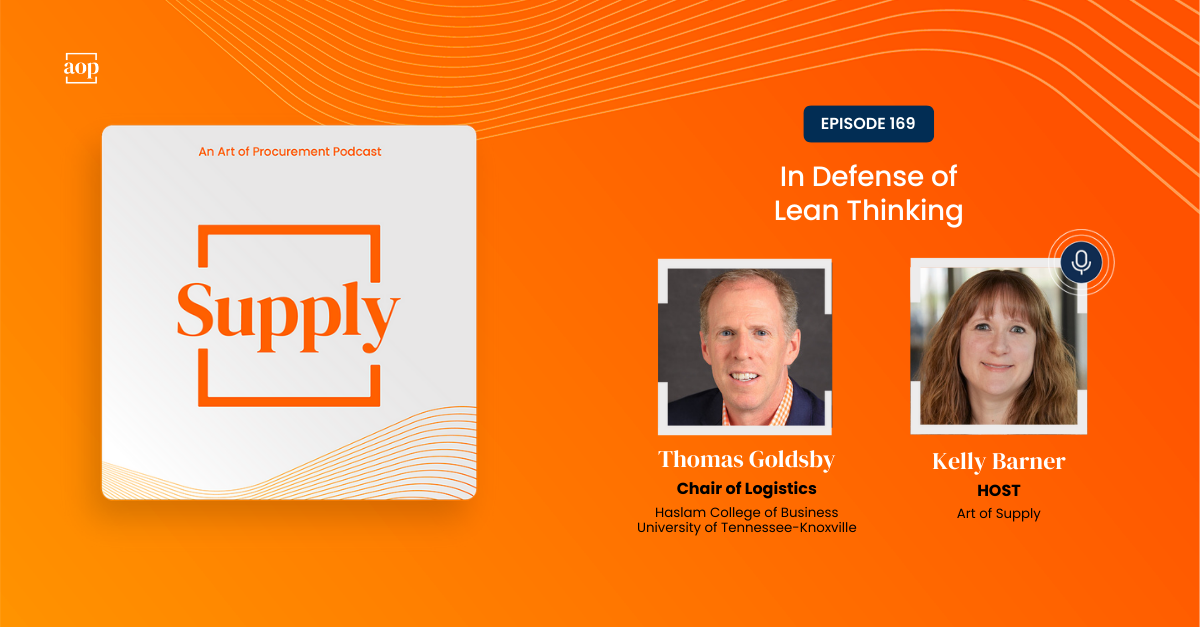
“If we think what's happened over the last three decades, as we offshored more of our operations and extended our supply chains, if we go back to the roots of lean thinking, it would suggest, listen: if we're just trying to take the inventory out of the system, we're very likely to experience a shipwreck.” -Tom Goldsby, Professor of Supply Chain Management at the University of Tennessee, Knoxville
Years ago, the pandemic hit supply chains hard when low inventory levels meant shelves went bare and shortages continued. Who, or rather what, took the blame for that chaos? Just-in-time and lean thinking. Now, with looming trade wars and supply chain leaders scrambling to reshore inventory before tariffs rock their wallets, lean thinking is making a comeback for procurement strategy and problem solving–or is it?
I recently sat down with Tom Goldsby to talk about the rebound timing for lean thinking. A Professor of Supply Chain Management at the University of Tennessee, Knoxville, the Dean and Jimmy Haslam Chair in Logistics, and Co-Executive Director of the Global Supply Chain Institute within the Haslam College of Business at UT Knoxville, he holds a lot of knowledge about the micros and macros of the topic.
Lean Thinking was Misunderstood and Misused
Tom admits that just-in-time (JIT) thinking took some heavy criticism during the pandemic. However, he argues that the issue wasn't JIT itself, but rather how it was applied. Many companies adopted just-in-time as a shortcut to reduce inventory without fully understanding the lean philosophy behind it. Tom argues that lean thinking isn’t about just shrinking inventory for the sake of cost, but rather “lean thinking, at its essence, is about process… understanding the capabilities and limitations of your processes.”
Problems also arose because organizations applied lean thinking without accounting for increasingly global and fragile supply chains. The old school way of thinking better applied to smaller supply chains that were, at the very least, contained to a single continent. When you add an entire ocean between inventory touch points, things get a lot more complicated.
When companies don't understand lean thinking and apply it superficially, global disruptions can easily expose their weaknesses, leading to the mess we saw during the pandemic. It also didn't help that supply chain leaders were not always the ones making decisions to adopt new ways of thinking.
Tom recalls how conversations went before the pandemic saying, “A lot of CFOs said, ‘you mean I can reduce the inventory investment or we can push that burden upstream in the supply chain? Tell me more.’ But I think we lost their interest once we got into the operational jargon that we inevitably get into when we talk about how this would actually work.”
As reshoring (re)gains momentum, supply chain leaders need to keep lean thinking’s original strengths–increased quality, faster response times, and better visibility–in mind to avoid misalignment. That’s only achievable by putting in the hard work that leads to high-performing, reliable, stable processes.
Walking the Walk, or Just Talking the Talk?
When we talk about lean thinking, Tom often finds that the pendulum swings between two scenarios. There were the situations “when companies were so desperate for that inventory, and that's when JIT and lean thinking in total were being thrown under the bus routinely.” That’s one we want to get away from. In other cases, CFOs were feeling the organization was too inventory-heavy and wanted to implement lean thinking to “lighten the balance sheet of the inventory and other working assets and capital.”
It seems that the praise or rejection of lean thinking can flip on a dime. As organizations revisit the strategy in the wake of tariffs, it's fair to question if their commitment to lean thinking is genuine or a shallow commitment that they will use as a scapegoat if or when things don't go their way.
Tom argues that the value of lean thinking comes from its effectiveness as a resilience strategy, not just a financial tool. “If you're a lean purist like me…[it comes down to] process mastery, problem solving,” he says. If organizations actively apply lean thinking, for what it is and not just the superficial idea of it, they can reevaluate their sourcing models and invest in resilient processes long before tariffs or any other disruption makes it necessary.
“There are tremendous opportunities for those individuals, those companies, those supply chains that can kind of figure out things a little sooner than the rest and become the model for others to follow. They're going to enjoy a huge advantage.”
Customer Value Needs to Be the Priority
The pandemic created enough stress and chaos for customers needing the products that supply chains, for a number of reasons, couldn't deliver. Now as tariffs and trade wars threaten to further impact everyday buyers, Tom urges supply chain organizations to rethink how they use lean thinking to deliver customer value.
“Lean thinking can and should be applied to every enterprise on the planet… to master the processes and understand what you can reliably count on,” he claims. One of the ways that lean thinking can solve, and even prevent, challenges is through supply diversity– but not every organization is poised to take advantage of this.
Tom pointed out, “Those folks that have failed to diversify over the last five, seven years…they're probably feeling more vulnerable than the rest. [Meanwhile], The folks that have been looking for alternative sources of supply…have been entertained by pretty savvy companies.”
Organizations that didn't put all of their eggs in one basket can now balance the risks and costs that come with disruptions, while still delivering a good product and maintaining customer responsiveness. That's classic lean thinking, focused on long-term value, rather than short-term gain.
As more companies revisit the idea of lean thinking, they need to return to its roots: a deep understanding of processes and a strong Focus for the people this strategy impacts. Only time will tell if organizations adopt JIT correctly or if we’ll see a repeat of the past.
Links:




